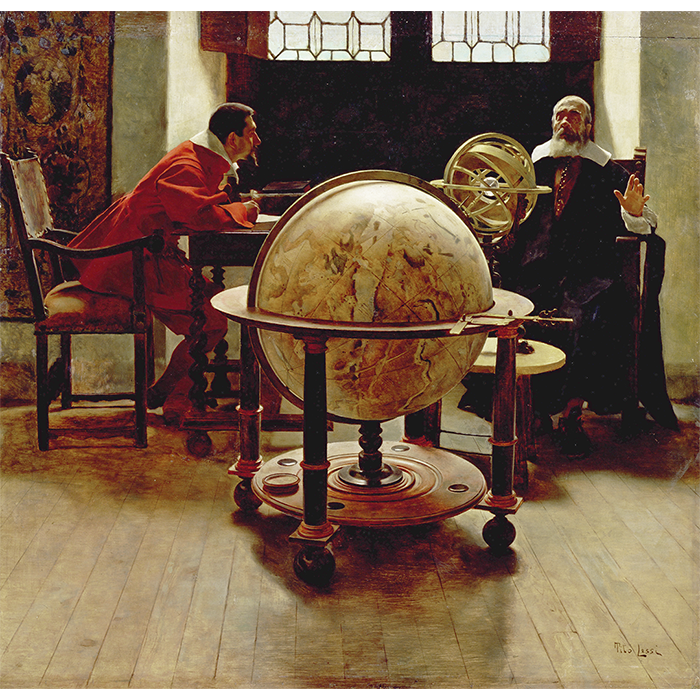Memorabilia and works of art
Testimony to the fortune of Galileo's myth preserved in the museum
Bust of Galileo Galilei
GROUND FLOOR
The plaster bust, painted in ivory to imitate marble, is one of the numerous works of Galilean subjects signed by the sculptor Aristodemo Costoli and dates back to the two-year period 1840-1842. Its origin is probably linked to the statue commissioned from Costoli for the Galileo Tribune on the occasion of the third congress of Italian scientists.

Middle finger of Galileo's right hand
ROOM VII
This item exemplifies the celebration of Galileo as a hero and martyr of science. The finger was detached from the body by Anton Francesco Gori on March 12, 1737, when Galileo's remains were moved from the original grave to the monumental tomb built on the initiative of Vincenzo Viviani. The finger became the property of Angelo Maria Bandini and was long exhibited at the Biblioteca Laurenziana. In 1841, the relic was transferred to the just-opened Tribuna di Galileo in the Museo di Fisica e Storia Naturale. Together with the Medici-Lorraine instruments, it was eventually moved to the Museo di Storia della Scienza in 1927. On the marble base is carved a commemorative inscription by Tommaso Perelli.

Galileo's objective lens
ROOM VII
Objective lens used by Galileo for many observations in 1609-1610. In 1610, he was the first to observe Jupiter's moons, which he called the "Medicean Planets." He announced his great discovery in Sidereus Nuncius [The Starry Messenger], published in Venice the same year. Galileo donated the lens of the telescope with which he made the discovery to Grand Duke Cosimo II. At a later date, the lens was accidentally cracked. After Galileo's death (1642) the lens was kept in the Guardaroba [Wardrobe] of Prince (later Cardinal) Leopold de' Medici. When Leopold died (1675), the lens was added to the Medici collection in the Uffizi Gallery. The collection remained there until 1793, when it was transferred to the Museo di Fisica e Storia Naturale. In the mid-nineteenth century, the lens was displayed in the Tribuna di Galileo with other Galilean memorabilia.
In 1677, the Medici commissioned Vittorio Crosten to build the ebony frame in which the lens has since been preserved.

Bust of Galileo Galilei
ROOM VII
Cosimo III de' Medici commissioned this striking sculpture from Carlo Marcellini, who was working at the Academy of Sculpture in Palazzo Madama in Rome. The artist shows Galileo with his head slightly turned toward the right with respect to the central axis of the bust. In his right hand, beneath the fold of his cloak, he holds two of the instruments that had most contributed to his renown: the geometric and military compass and the telescope.

Galileo and Viviani
ROOM VII
Tito Lessi's painting shows Galileo in old age with Vincenzo Viviani. After his condemnation in 1633, Galileo was confined to the villa Il Gioiello in Arcetri, where Viviani assisted him from 1639 until his death in 1642.

Galileo and Milton
ROOM VII
Annibale Gatti's painting shows the presumed meeting of the poet John Milton with Galileo confined in the villa Il Gioiello in Arcetri, where the scientist spent the last years of his life after the condemnation of 1633.

Galileo's commemorative coin
REPOSITORY
The medal, dated around 1680 and created by Giovan Battista Foggini commissioned by Vincenzo Viviani, reproduces on the obverse the clear profile of Galileo characterized by locks of wavy hair and a slightly squared beard, dressed in a finely crafted draped cloak.
The indication of the scientist's age, 50 years («AETAT L») and the reference to the Accademia dei Lincei («GALILEVS LYNCEVS») are then shown in the section of Galileo's arm.
The other side of the medal becomes a small visual compendium of Galilean studies and discoveries, accompanied by a famous verse from Ovid's Metamorphoses («NATURAMQUE NOVAT»), where it is possible to recognize a cannon from which a projectile emerges which describes a parabolic line, a broken column on two pyramid supports together with a compass and a pendulum.
Furthermore, you can easily identify a telescope, a lighthouse, a ship on the high seas as well as the setting Sun with the phases of the moon around it, as well as recognizing the planet Jupiter with the orbits of its satellites, the crescent Moon and a comet.


 EN
EN  IT
IT 
